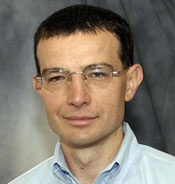Program Information
Research Opportunities with Digital Linear Accelerators
D Hristov
Q Wu
K Sheng
V Yu
S Nill
D Hristov1*, Q Wu2*, K Sheng3*, V Yu3*, S Nill4*, (1) Stanford University Cancer Center, Palo Alto, CA, (2) Duke University Medical Center, Durham, NC, (3) UCLA School of Medicine, Los Angeles, CA, (4) The Institute of Cancer Research, London, UK
Presentations
7:30 AM : Trajectory Modulated Arc Therapy: Application to Partial Breast Irradiation - D Hristov, Presenting Author7:54 AM : ET-reloaded - Q Wu, Presenting Author
8:18 AM : 4n Radiotherapy - K Sheng, Presenting Author
8:42 AM : Quality Assurance for Advanced Digital Linac Implementations - V Yu, Presenting Author
9:06 AM : Using a research real-time control interface to go beyond dynamic MLC tracking - S Nill, Presenting Author
TH-AB-BRB-0 (Thursday, August 4, 2016) 7:30 AM - 9:30 AM Room: Ballroom B
Current state-of-the art digital C-arm medical linear accelerators are capable of delivering radiation treatments with high level of automation, which affords coordinated motions of gantry, couch, and multileaf collimator (MLC) with dose rate modulations. The new machine capacity has shown the potential to bring substantially improved radiation dosimetry and/or delivery efficiency to many challenging diseases. Combining an integrated beam orientation optimization algorithm with automated machine navigation, markedly improved dose conformity has been achieved using 4π therapy. Trajectory modulated radiation therapy (TMAT) can be used to deliver highly conformal dose to partial breast or to carve complex dose distribution for therapy involving extended volumes such as total marrow and total lymph node treatment. Dynamic electron arc radiotherapy (DEAR) not only overcomes the deficiencies of conventional electron therapy in dose conformity and homogeneity but also achieves so without patient-specific shields. The combination of MLC and couch tracking provides improved motion management of thoracic and abdominal tumors. A substantial body of work has been done in these technological advances for clinical translation. The proposed symposium will provide a timely review of these exciting opportunities. The goals and learning objectives of this symposium for the AAPM membership are:
1. Recognize the potential of using digitally controlled linacs for clinically significant improvements in delivered dose distributions for various treatment sites.
2. Identify existing approaches to treatment planning, optimization and delivery for treatment techniques utilizing the advanced functions of digital linacs and venues for further development and improvement.
3. Understand methods for testing and validating delivery system performance.
4. Identify tools available on current delivery systems for implementation and control for such treatments.
5. Obtain the update in clinical applications, trials and regulatory approval.
Funding Support, Disclosures, and Conflict of Interest: K. Sheng, NIH U19AI067769, NIH R43CA183390, NIH R01CA188300, Varian Medical Systems V. Yu, Varian Medical Systems, AAPM Summer Undergraduate Fellowship, NSF graduate fellowship S. Nill, Elekta AB. Cancer Research UK under Programme C33589/A19727, NIHR Biomedical Research Centre at The Royal Marsden and The Institute of Cancer Research.
Handouts
- 115-31555-387514-118526.pdf (D Hristov)
- 115-31556-387514-118563.pdf (Q Wu)
- 115-31557-387514-118709.pdf (K Sheng)
Contact Email:





